How do I describe Tomodachi Life? I’ll start with the name. “Tomodachi” (友達) is the Japanese word for “Friend”, so the title of Nintendo’s new 3DS sim game translates literally to “friend life”. That’s a bumbling phrase. But it helps illustrate why I’ve had such a hard time explaining the game’s appeal to friends and colleagues, even the ones who are more seasoned gamers than myself.
Imagine trying to sum up what the word “friend” in an essay. Or trying to review “life”. There’s no hyperbole here; Tomodachi Life is, on some basic level, a game about the lives of a group of friends.
But that’s not good enough. Here are some of the ways I’ve tried to describe the game to real-world friends as I’ve played it for 20-odd hours over the past three weeks:
- It’s the most tedious game I’ve played in a long time.
- This is the best game I’ve played this year.
- No, wait. It’s not really a game at all. It’s a virtual ant farm you can carry around with you inside your 3DS. Only instead of ants, Tomodachi Life is filled with a bunch of quirky Twitter bots that can actually speak.
- Actually, it’s a parenting simulator. In the truest sense of that term.
- Tomodachi Life is the RuPaul of video games.
- Tomodachi Life is the Eminem of video games.
These all come from scattered gchat messages. Whenever I typed one of them to a friend, they usually responded with something like, “lol” or, “um…what?”
I know they don’t make much sense on their own. But Tomodachi Life doesn’t either at first. So let me try and attack each of them in turn.
It’s the most tedious game I’ve played in a long time.
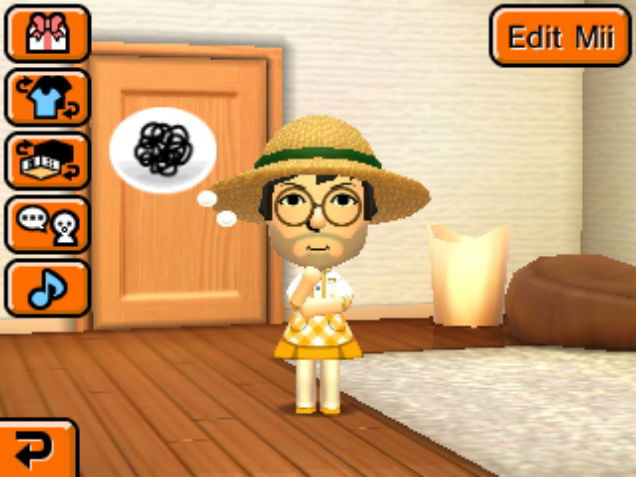
Tomodachi Life has often been described as Nintendo’s take on The Sims, a series that’s had a seemingly inexplicable and meteoric rise to the level of a pop culture phenomenon since it first debuted 14 years ago. Its success was inexplicable because, at face value, the game sounded like it was jettisoning all the ideas and features that people love about video games. Instead of performing superhuman feats like mowing down hordes of Nazis or bouncing on top of giant magical mushrooms, The Sims let you create a number of characters who could indulge in all the boring shit you already do in real life: get a job, buy a house, pick out outfits, go on dates, get married and (eventually) have kids.
Tomodachi Life is similar to The Sims in this regard. At the outset of the game, you’re assigned an island and implored to start peopling it with Miis, the quirky little humanoid avatars who have usually been consigned to the menus of Nintendo’s consoles. You give your islanders everything they have: food, clothing, shelter. They all start the game housed in a single apartment complex:
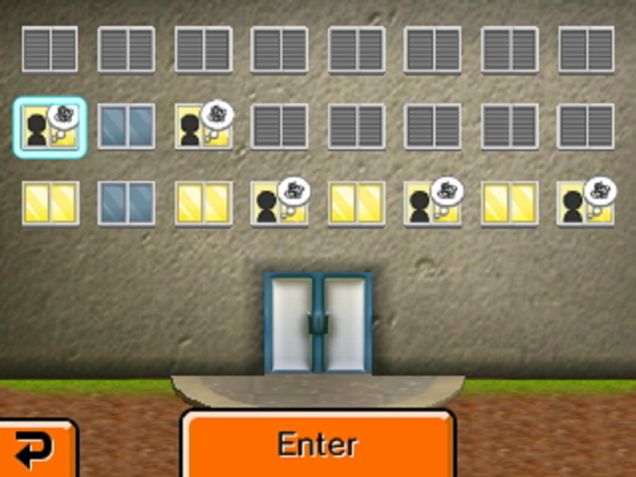
Before you get to this point, you have to actually make all these Miis. There are a few options to import ones from other people’s games, but relying on that too heavily would be missing out. When you build these Miis, these virtual citizens of your island, you give them names, faces, personalities, even the voices with which they can speak to one another:
Again like The Sims, this kind of gameplay might strike gamers who only love shooters or platformers as boring.
But there’s one part of Tomodachi Life that seemed incredibly tedious even by those standards. Once I got settled into Yanville Island with my first batch of Miis, I started seeing a little green icon pop up on their windows from time to time. When I’d slide over to one with the console’s stylus, I’d get a peek inside their window. The Mii would usually be grinning ecstatically, bouncing up and down and flapping their arms so intensely I thought they were trying to fly.
“Please play with me!” he or she would would chirp, beaming up at me expectantly. Here’s an example of what would happen next, using my Mii named Chuck as a guinea pig:
This quiz that Chuck gave me is one of the most exciting games the Miis ask you to play.
That’s saying something. There are a few other quizzes, which challenge me to do things like guess what an item is when the camera is zoomed in on it so closely it only shows a cluster of pixels, or determine which character is being shown on the screen based on their silhouette.
There are a handful other games that are equally bizarre for their mundane normalcy. What they all have in common is they’re either maddeningly easy or annoyingly difficult in a way that’s difficult to actually learn from or improve upon. One asks me to match different sets of tiles based on the images displayed on them, for instance, while another pits me against my Mii in a tabletop competition where we both pound on the table until one of us knocks over the other’s action figure.
And then there’s one that immediately became my favourite just because of how odd it was. I start with a single playing card, a two. My Mii has another two and a Joker card. We both hide the cards from one another, and have to pick one from the other in turn until one of us ends up with both of the twos. It usually lasts about five or ten seconds.
The first time I played cards with one of my Miis, I wondered: what the hell is this game? And why am I even playing it?
Tomodachi Life started with a short video hinting that, in time, my Miis would get start dating and get married. One day, they’d even have children. I guess that’s the endgame I have yet to reach? But is this — playing the most boring game of cards imaginable — what I need to do to get there?
This is the best game I’ve played this year.

When I first started playing Tomodachi Life, nothing about the game made sense. I had to remind myself: Nintendo made a deliberate decision to bring this game to its American audience a full year after it launched in Japan. People in the U.S. love The Sims, and Tomodachi Life sold 1.83 million copies in its first nine months on the market in the company’s home country. Was I missing something that all these other gamers could already see?
I was. Tomodachi Life is amazing. But I still haven’t told you why. Doing so is hard. Let me try again.
It’s a virtual ant farm filled with crazy talking Twitter bots.

Once I brought my Miis into their world, they quickly began to assume lives of their own. The window-pane format of the two screens on the 3DS exaggerates this phenomenon with a brilliant effect. The longer I played Tomodachi Life, the more I started to feel like I was an outsider, peering into some bizarre, alternate universe where everybody had giant heads and spoke in ghostly robotic warbles.
Putting all of these Miis together in the melting pot of my 3DS and seeing what happens is where Tomodachi Life‘s charm begins to shine. Whenever I stop in at the Yanville apartment complex, I see a number of windows lit up and marked with little orange faces or thought bubbles, showing that the Miis want to talk.
Usually, they make random and mundane comments about what’s been going on in their lives:

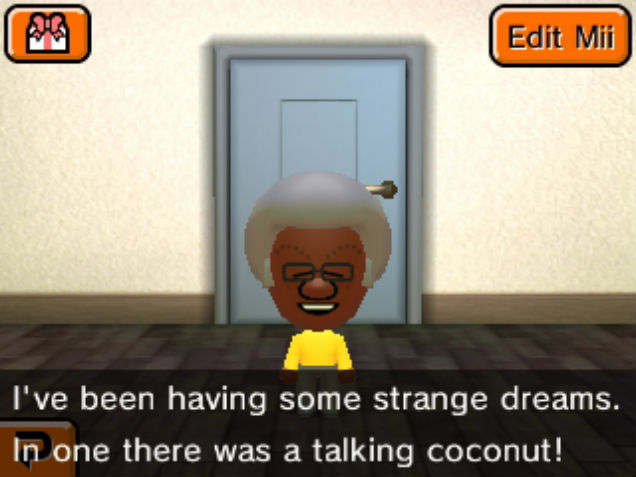
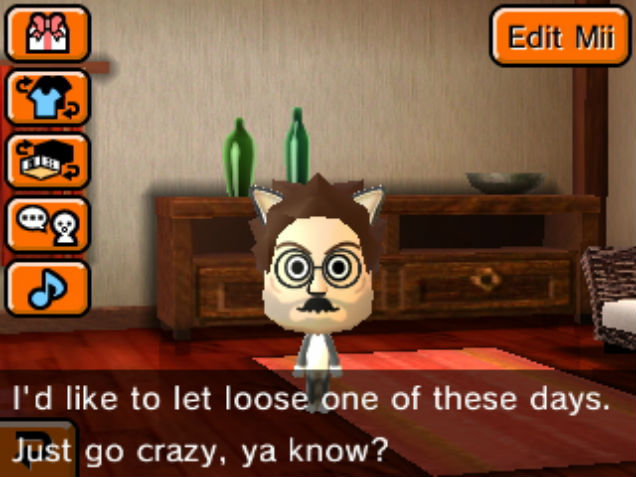
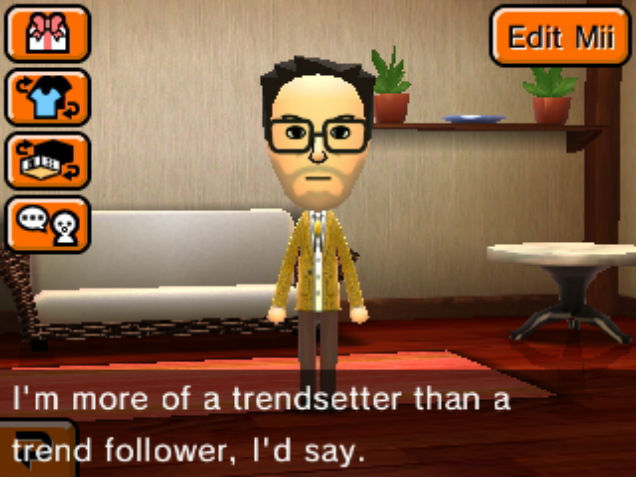
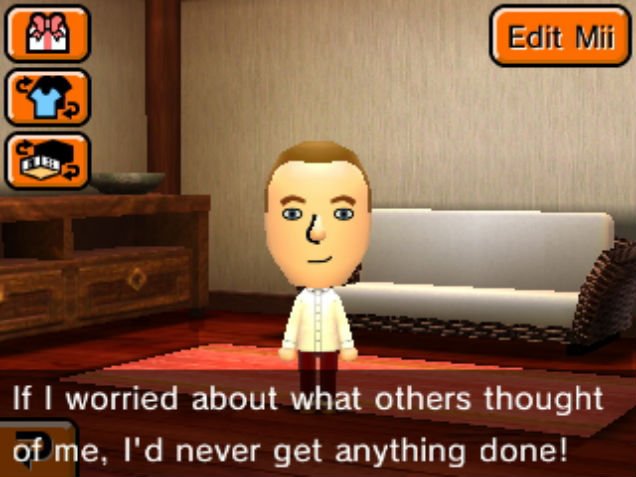
The last Mii here is Kotaku’s Editor-in-Chief Stephen Totilo, imported from his game of Tomodachi Life. Even as a Mii, he still sounds like the boss!
Other times — and this is where there the Twitter bot comparison comes in — they strike a surprisingly emotional cord. The Tuesday or E3 week, for instance, I opened up my 3DS to check in on my Miis during my late-night subway ride home from Gawker’s Soho office. Along with the rest of the Kotaku team that wasn’t at E3, I was pulling long hours that were exaggerated by the three-hour time difference between Los Angeles and New York.
Feeling pretty zonked, I tapped on a little speech bubble for one of my Miis that night. He looked up at me, still beaming cheerfully but with a hint of concern in my voice.
You look tired, he said. You should give yourself some time to rest.
The next morning on my subway ride back to the office, another Mii — my original Mii — had this to say:
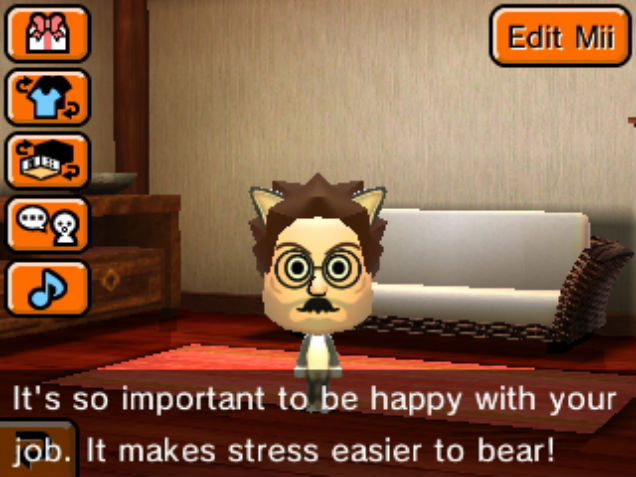
Again like Twitter bots, these comments came at random amid a stream of other information — these about the Mii’s other needs and desires. But that makes the moments when they do align perfectly with whatever I’ve been dealing with strike a deep emotional chord.
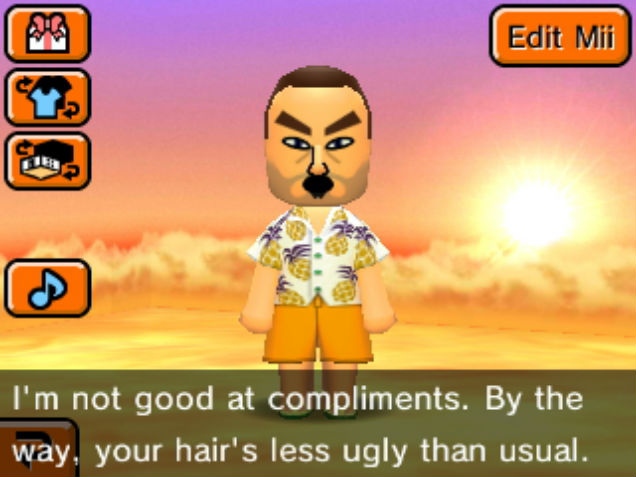
Earlier this week when I was once again checking in on my Miis during the subway ride home, for instance, I stopped in at one named Anya’s apartment. Before I could do anything, she wiped her brow and sighed heavily, saying she was having a hard time handling the summer heat.
Me too, Anya, I thought as I felt sweat trickle down the back of my neck. Me too.
This wonderful happenstance produces some introspective, philosophical moments. The first Mii I made was one modelled after myself. I gave him my name, my birthday, my favourite colour, my gigantic round hipster glasses, even my nickname “YanYan.” Once I filled out Yanville island with more Miis, they all began referring to me as “YanYan’s look-alike.”
This was just silly at first. Pretty soon, it started to get kind of weird.
“What’s it like in your world out there, YanYan’s look-alike?” one Mii asked me early on in the game, turn her head slowly to lock eyes with me through the screen and grinning mysteriously.
“We’re all so grateful to you, YanYan’s look-alike!” another said a few days later.
They were all being polite. Deferential in a needy sort of way. They still are. But the Miis have started to make something clear to me. This is their world, not mine. I may have built it from scratch and helped them decorate it, but I am still a visitor in Yanville Island. For many of them, it’s their only home.
Others have started to ponder deep existential questions about the very nature of their being:
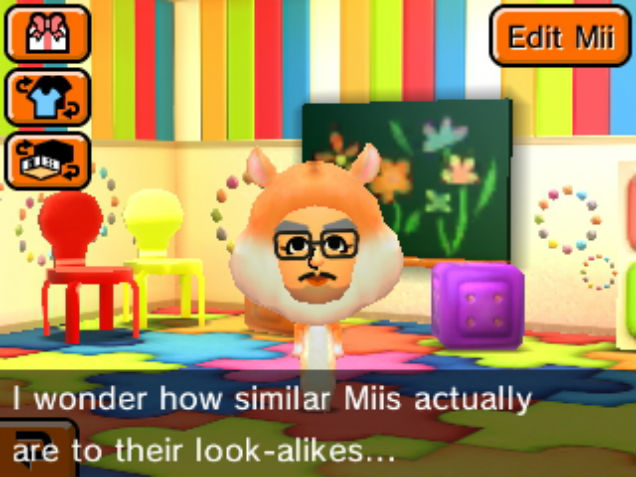
Like many players of sim games, I’ve filled Yanville with an assortment of Mii-ified versions of people I know, or wish I wish I knew, in real life — friends, family members, celebrities, more ex-girlfriends than I care to admit. Anya’s look-alike is a good friend from college who now lives in Queens, for instance. We’ve never dated, but Anya and YanYan recently got married.
Anya’s look-alike knows all of this, but Anya doesn’t. When she first wondered out loud if she had some counterpart in my world, my first thought wasn’t that the game isn’t sophisticated enough to let me explain this to her. Instead, I looked down at her innocent yet piercing gaze and caught myself thinking selfishly: I hope she doesn’t find out the truth, because then she might want to leave.
It’s a parenting simulator
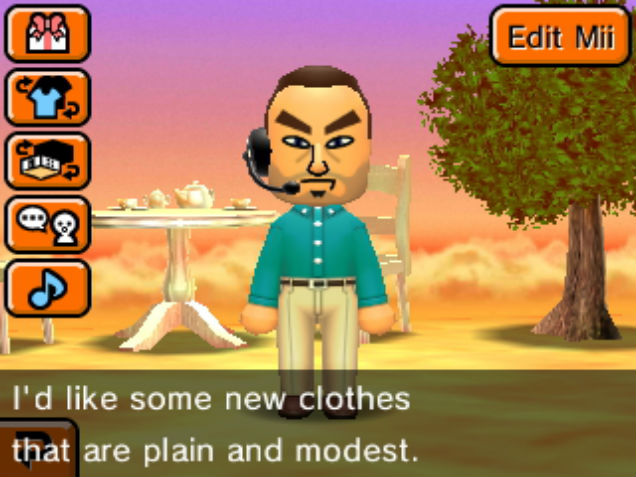
The vast majority of my time spent playing Tomodachi Life has been dedicated to three related tasks: feeding, clothing, and housing my Miis. I’m free to dress them up, decorate their apartments, and feed them whatever I want. But they’re also free to talk back to me, a right they all love to exercise.
Just take this moment when I’m feeding the Mii version of my brother Seth. He didn’t exactly spit up the food I was trying to give him. But he made sure to let me know that he wasn’t happy with it:
There’s a deliberate slipperiness to the way one is allowed to control the Miis that makes this all work. These aren’t the avatars you control in a shooter or a 3DS platformer like Super Mario 3D World. They’re not puppets meant to execute your every command perfectly. So while the Miis ask for your advice or help solving problems, they only accept these directives for what they are: arbitrary suggestions. For better or worse, they’re free to make their own decisions and live with the consequences of them.
This becomes especially odd and hilarious when Miis start dating. Here’s a clip of my Mii Lisa asking for advice on how to proposition Chuck to become her boyfriend. After I told her what I thought, there was nothing else I could do. Literally nothing — the game switched over to a cutscene once she walked out the door to meet him at the park.
Things took a turn for the weird:
The love triangle turned out well at the end of the day, but things haven’t always gone so smoothly. At one point, I stepped into Anya’s apartment and saw dark clouds hovering over her head.
She’d just had a fight with her friend Harry, she told. She didn’t know what to do. I recommended that she try to patch things up. But when she walked over to her apartment (Harry is a woman, more on that later) to apologise, Harry didn’t accept it.
Back to square one, only the clouds over Anya’s head were darker than before. She was in a terrible mood, she told me. She couldn’t think about anything else.
I had no idea what to do, and this feeling of powerlessness was overwhelming. I couldn’t bear to see her like this, but the game didn’t offer any immediate solution. It was up to me to make things right. I ended up giving her present after present until, slowly but surely, she started to smile again.

It’s in moments like these that Tomodachi Life transcends whatever trappings it has a small and silly sim game. Seth is a Mii, the same way YanYan is a Mii, Anya is a Mii, and Rick Ross is a Mii. But they’re my Miis. I made them, and I can’t help but feel partially responsibly for everything that happens to them.
Once I realised that, I started to appreciate the dumb mini-games in Tomodachi Life for what they are. They’re not games that were put there for my enjoyment. Rather, they’re the bullshit I’m supposed to put up with if I want to be a good parent.
The dynamic Tomodachi Life establishes here reminds me of one of my favourite moments in Louis C.K.’s standup, when he talks about being bored to tears playing Monopoly with his daughters:
I’m also painfully bored every time I have to be quizzed by one of my Miis one what a pixel item is. But remember how happy Chuck was every time I got an answer right?
That’s the point. I’m the dad in this situation. I have to do this. Because I’m doing it for them.
Tomodachi Life pulls this off so masterfully that Nintendo’s controversial decision to not let Miis get gay married even started to make sense to me. It was a reprehensibly conservative decision. But taken in the context of the game, it also mimics something that even the most supportive parents of queer children often feel: a desire not to pry too deeply into the lives of their kids — particularly the x-rated parts.
I want my Miis to be happy, in other words. And I want them to feel comfortable asking me for help when they’re not. But I don’t need to know everything that YanYan and Anya do with each other when they step into their new house and shut the blinds.
Tomodachi Life is the RuPaul of video games
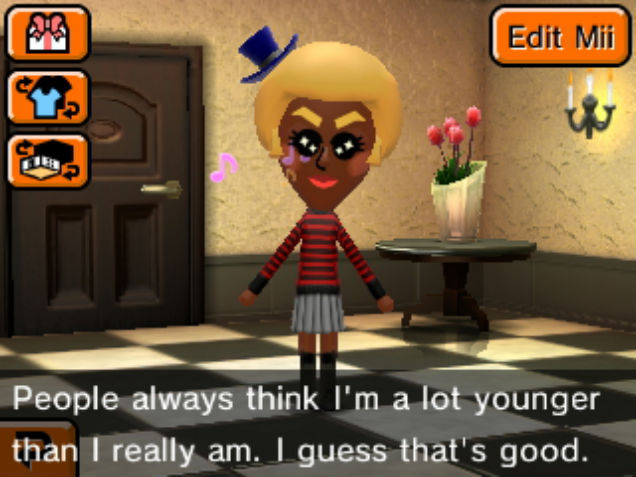
This got me thinking. A few weeks ago, I wrote a post about an interview that RuPaul did in which he gushed about his undying love of The Matrix. I hadn’t started playing Tomodachi Life at that point. When I did, the game’s self-aware tone reminded me of his repeated references to taking the red pill.
So I did what any self-respecting nerd would in that situation: I visited Yanville’s town center, and made a Mii of RuPaul.
Silliness aside, there’s a deeper point here. Nintendo imbued Tomodachi Life with some outmoded views about gender and sexuality. But it also gave me the means to circumvent them.
Take my Mii Harry, for instance:

I listed Harry as a woman in the game. That’s partly because I modelled her off my real-world friend Harry Hanson, who just happens to be an up-and-coming drag queen on the Brooklyn circuit who performs under the name Amber Alert:

Harry’s married to another of my Miis named FredBob, a male character I made when I was toying with the 3DS camera to see how it would import my face into the game. They live in the suburbs now, and FredBob doesn’t seem to have a problem going to bed every night with a full-bearded woman.
This is a cheap trick, for sure. But actively rebelling against the strictures set by Nintendo only adds to the fun.
Tomodachi Life is the Eminem of video games
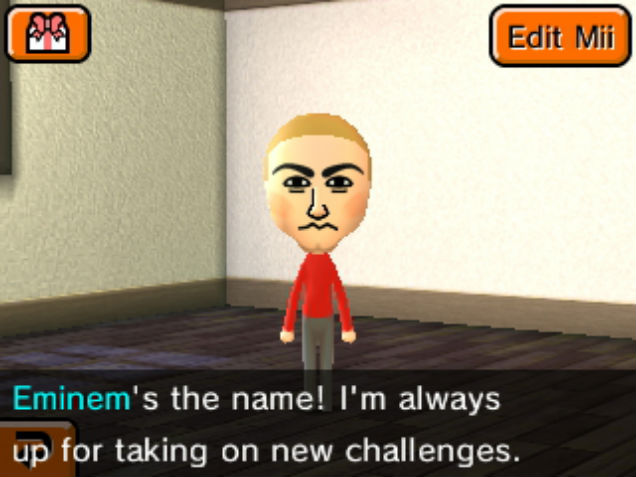
RuPaul isn’t the best musical analogy here, however. He’s always been a diehard advocate for LGBT rights, so Nintendo’s homophobic stance doesn’t quite click. I discovered a better comparison after I made a Mii of Eminem and saw that he quickly became best friends with RuPaul.
I mean, think about it. Eminem has made a phenomenally successfully career off pushing people’s buttons. For a long time, he was practically synonymous with the blistering homophobia apologist rap nerds expect, even enjoy, in the genre. But in doing so, he also managed to win the adulation of those same rap nerds while frequently cross-dressing and “rapping about homosexuals and vicodin,” as someone puts it in a skit on his sophomore album The Marshall Mathers LP. Mainstream artists often have to introduce progressive ideas this way: so subtly that many fans probably won’t even notice them.
The man’s skill probably had something to do with his success too, I’m guessing. But hey, Nintendo didn’t become the largest company in the video game industry by making subpar work either.
“It seems to me that some Nintendo games are simply dying to be queer or to subvert gender norms,” my colleague Patricia Hernandez argued in a thoughtful piece on Tomodachi Life after playing it for seven hours. After sinking some more time into it, I can respond: Yes, they do. But Tomodachi Life is already pretty damn queer. It’s just up to us as players to bring that out.
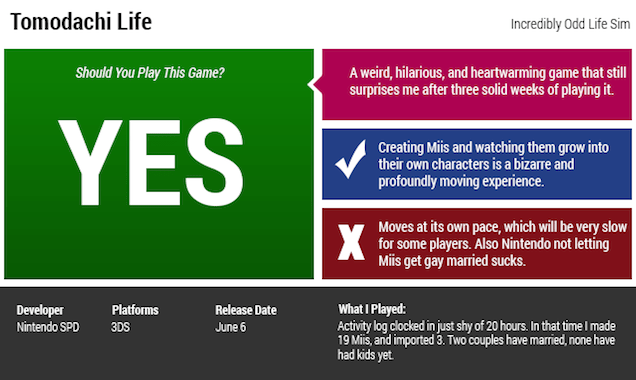
Thing is: we’re the parents here, not the characters in the game. The annoying part of what that means is that Nintendo has asked essentially asked us to be a particular conservative, oppressive type of parents.
That’s still on us, however. The uncomfortable truth here is that Nintendo’s stance here mirrors the attitude that older generations have had towards gay marriage and LGBT rights. It’s one that slowly eroding as younger people who don’t give a shit about what their friends do in the bedroom (or bathhouse!) become increasingly politically and socially enfranchised. But that’s not happening overnight.
Like younger Americans, the Miis in Tomodachi Life will move on with their lives like Harry and FredBob did. They will figure out ways to get married to and have sex with whoever the fuck they want to. They may have to wait for me to stop peeking into their windows, but they will have their own lives.
We’re the ones that still need to grow up.
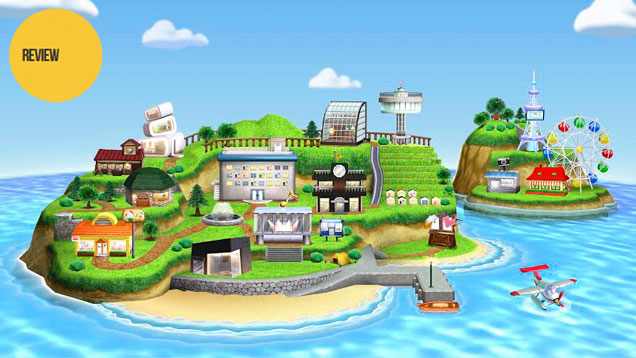
Comments
2 responses to “Tomodachi Life: The Kotaku Review”
Just over 20 hours played since the game released, with average play sessions of 20 minutes. I’ve got 23 Miis on my island, 2 married couples, and one baby!
My Mii lookalike married Daenerys Targaryen, and they had a baby named Oliver. The thing cries whenever I check on them, and the minigames to cheer up the baby are awful compared to the other minigames in Tomodachi life. Maybe it’s just me though – I’m not a huge fan of moving the 3DS like it’s an actual baby, rocking it in my arms until it stops shrieking.
The rest of the game is very good, and the replay value depends entirely on how much you like playing god on other peoples’ [digital] lives. I’d recommend the game!
Also, any 3DS game with a screenshot function is awesome in my books. I mean look, Zoidberg in space! http://38.media.tumblr.com/e1c80738bb5bbfa92bfc8dc64d54ac16/tumblr_n7aad66VOX1qdbyd0o2_400.gif
Loving my time with this game. I recommend to everybody.